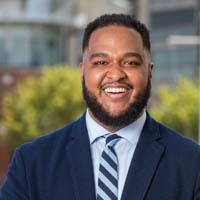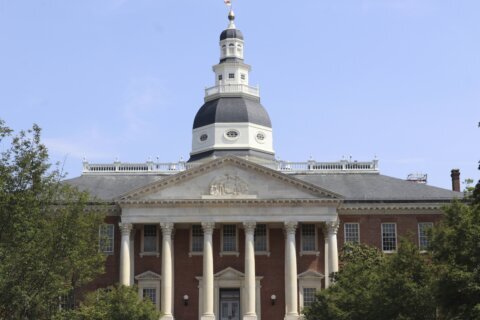This article was republished with permission from WTOP’s news partners at Maryland Matters. Sign up for Maryland Matters’ free email subscription today.
This content was republished with permission from WTOP’s news partners at Maryland Matters. Sign up for Maryland Matters’ free email subscription today.
The 2020 census revealed that Latinos grew from 8% of the Maryland population in 2010 to 12% in 2020, making representation in government more critical than ever, Latino leaders said Thursday.
“Representation matters because if we’re not present, we are an afterthought. We are invisible,” Del. Joseline Peña-Melnyk (D-Prince George’s) said in a virtual discussion about Latino representation with Maryland Latinos Unidos, a statewide network of organizations and businesses that support Latino and immigrant communities, on Thursday.
During the past legislative session, lawmakers like Peña-Melnyk supported expanding Maryland’s Earned Income Tax Credit to provide relief for thousands of tax-paying immigrants, who were left out of the state’s RELIEF Act because they don’t have a Social Security number.
Immigrants who do not have a Social Security number contributed over $139 million in taxes over the last year, but are prohibited from benefiting from certain social assistance programs that require Social Security numbers, according to Peña-Melnyk. This bill accounted for the immigrant population.
In 2013, the General Assembly passed a bill that allowed people to get a driver’s license without having to prove their immigration status.
If it were not for Latino representation in government, there would have been no argument for why it was important for undocumented people to have a driver’s license or for someone to speak for tax-paying immigrants who were left out from the state’s RELIEF Act, Peña-Melnyk said.
During the height of the COVID-19 pandemic, the immigrant Latino communities in Langley Park, Hyattsville and Adelphi in Prince George’s County had the highest number of positive cases in Maryland.
If there was a Latino representative during high-level discussions about where to place COVID testing sites, the state could have realized earlier that most people living in those communities are immigrants in multi-generational homes and so may be more susceptible to contracting COVID, Peña-Melnyk said. They also may lack the transportation to go to a testing site or face language barriers.
In the end, Peña-Melnyk said she brought CASA, a Latino and immigration advocacy group, to the table to partner with the state and county governments to help the Latino community living in Langley Park and Hyattsville.
Montgomery and Prince George’s counties have the highest concentrations of Latino population in the state, with 21% in each jurisdiction, census figures have shown.
However, being one of the four Latino legislators out of the 188 lawmakers in the General Assembly can get lonely, Peña-Melnyk said. The Maryland Legislative Latino Caucus formed relationships with the Legislative Black Caucus and added associate members to help amplify its voice, she said.
At the same time, it can sometimes be an isolating experience for a Latino person in a leadership role to suddenly become a figurehead and face unrealistic expectations from the community, said Laura Gutierrez, a Hispanic community services specialist for the City of Annapolis.
“Our people in these positions aren’t God — most are doing the best that they can. If we are not wanted by an entity…[and] we join the entity because of political pressure, it’s highly unlikely that that person is going to succeed,” she said.
Peña-Melnyk said government and corporate leaders must be intentional about including Latino representation in their offices and take the recruitment process seriously.
Earlier this month, a coalition of Latino leaders in Prince George’s County, including Peña-Melnyk, criticized the hiring record of County Executive Angela D. Alsobrooks (D)
Last month, Latino lawmakers took issue with the lack of representation on the Blueprint for Maryland’s Future’s accountability board. In response, Gov. Lawrence J. Hogan Jr. (R) asked the nominating committee to submit a new slate of nominees, but they declined, saying that they had already selected qualified candidates. Out of the 43 applicants that the nominating committee received, only two identified as Latinx, according to the committee.
Peña-Melnyk pushed back on the nominating committee’s decision to not choose the candidates who identified as Latinx. She said she knew them: one who was the president of the Maryland PTA and another who was on the Kirwan Commission.
“Don’t tell me that there were not qualified people,” she said. “What do we have to do to qualify? What are the standards that we have for our community?”
Forty percent of students in Prince George’s County are Latinx, but only one county school board member identifies as Latinx, Peña-Melnyk lamented. In 10 out of 24 counties in Maryland, Latino students make up more than 10% of the student body, according to Maryland Latinos Unidos. With a high portion of the Latino population in the student body, it is disappointing that the board tasked with ensuring education policy in the state does not reflect the state demographics, Latino leaders said.

As the General Assembly will soon tackle congressional redistricting in a special session in December, and then legislative redistricting in its regular session that begins in January, Ashanti Martinez, a research and policy analyst for CASA, stressed the importance of the redistricting process for the Latino community.
“We are carving out our communities and then we are able to elect members of those carved out districts that can go to the halls of power and speak truth to the issues that are facing our communities,” said Martinez, who is running for a seat in the House of Delegates in Prince George’s County’s District 22.
For instance, if subdistrict 47B in Prince George’s County, which is primarily Latino, were taken away, it would be much harder for Latinos to win office and have a seat at the table, he said — though the district is currently represented by Del. Wanika B. Fisher (D), who is Black and Indian-American.
Peña-Melnyk said she was encouraged by the progress of several Latino candidates in municipal elections in Prince George’s County this year, and said they are part of the “pipeline” of emerging political stars. That group includes Rocio Treminio-Lopez, who was reelected mayor of Brentwood; Mt. Rainier Mayor Celina Benitez, the first Latinx mayor in the city; Jenny Garcia, who was reelected to the Cheverly town council; Briana Urbina, elected first Latina in history to the New Carrolton Council; Rommel Sandino, elected first Latino in history to his ward on the Hyattsville City Council; and Karen Mejia, a new councilmember in Riverdale Park.
It is important for Latino leaders to mentor the future generation of leaders and to work collaboratively, speakers on the webinar said. “Those of us who are highly visible — we need to ensure that the next set of leaders is developed by putting them in committees, in projects, in sessions…we can’t hoard it all,” said Veronica Cool, the past chair of the Maryland Hispanic Chamber of Commerce.
“I’ll be honest, it is not easy to be in those rooms,” Cool said. But “if it’s only a handful of people like the Joselines of the world, we can’t do it all.”







